The first thing I noticed from Haitian drama Ayiti Mon Amour was the softness and coolness with which the film carries itself. Unlike many small-budget directors who fear inadequacy, director Guetty Felin never makes visible efforts to meet lofty or expensive standards of visual storytelling or artistic refinement. Shots from moving vehicles are kept intact, even at moments when the camera shakes enough that you can feel the separate elements of the equipment rattling through the image. Felin, conscious of the limits of her filmmaking potential, does not seek hyperrealism or minimalism in her film either. There is no abundance of dollies, cranes, and Steadicams for Haitian filmmakers, nor is there a steady supply of internationally trained actors. Yet she also understands where her vision has unique potential for success, and how that success can be achieved with her available resources.
Ultimately, Ayiti Mon Amour functions best as an exploration of identity, a work that tries to resolve the many external factors—racial, economic, environmental—that challenge and complicate the filmmakers’ understandings of their lived experiences as “Haitian.” The film strikes a chord with a particularly common Latin-American sentiment—a simultaneous distaste and yearning for the homeland. One of the lead characters, Orphée (Joakim Cohen), discusses his vacillating wishes to go back to France or the United States. In a parallel storyline, an author poetically personifies Haiti as a beautiful and caring woman, but also as something a little more.
The thematic narrative of the film goes hand in hand with the story’s elements of magical realism. Mermaids, divine powers, and other mystical developments engage with and give more substance to themes of nature, family, tradition, and community. Even the way some scenes begin, with an uncertain sense of viewer subjectivity, has an intriguing otherworldliness to it. Are the characters talking to other characters, to themselves, to “us,” or to something else, something less definable?
I can't pretend, after one viewing, to understand exactly how all of the separate components in Ayiti Mon Amour come together to make a narrative whole. There is no simple way of providing a plot summary. This is not due to a lack of coherence or storytelling ability, although Felin certainly has some room for growth in both areas. Instead, the film's slippery, transitory nature can be attributed to the fact that Felin and her fellow filmmakers are not “telling a story” so much as recounting a set of shared experiences that will inevitably be read and understood as a story. Felin invests a great deal of cultural energy into her film, not just in what she shows—gorgeous sea and land footage of the Haitian coast, crowds celebrating or marching on streets against the backdrop of dilapidated but colorfully vibrant urban landscapes—but also how and why she shows it. While this approach can make for a more challenging viewing experience the final product still possesses an equally grand and rewarding impact on all its viewers.






